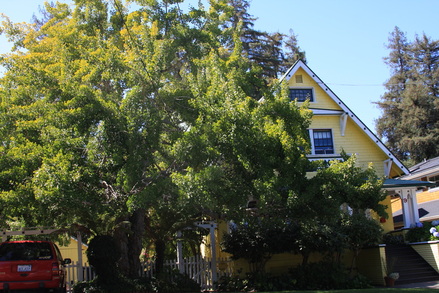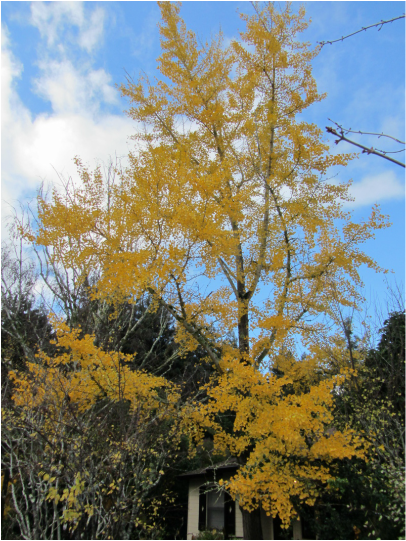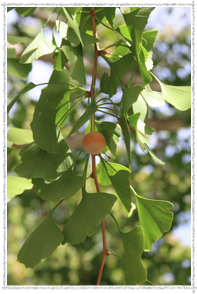|
Maidenhair tree (with leaves resembling those of maidenhair ferns, only much larger) is just as often referred to by its genus name Ginkgo. It only grows in the wild in two small areas in China, but 200 million years ago, the genus grew worldwide. It is botanically interesting because it is more closely related to Cycads than to other broad leaf deciduous trees. Ginkgo was introduced to America from China in 1784.
The tree at 9 Monte Vista is slightly atypical in appearance in that it has a broad, rounded crown. More often the profile is pyramidal. It can potentially grow to 80 ft. and live long. A healthy appearing specimen in Japan is reputed to be 1200 years old. The tree at 9 Monte Vista is slightly atypical in appearance in that it has a broad, rounded crown. More often the profile is pyramidal. It can potentially grow to 80 ft. and live long. A healthy appearing specimen in Japan is reputed to be 1200 years old. Flowers are produced on separate male and female trees. Be sure to plant a male because the female tree produce quantities of foul smelling fruit. If you choose a named cultivar such as ‘Saratoga’ it will be cloned from a male plant. Available cultivars vary in height and shape. THE GINKGO PAGES is a website that contains a huge amount of information about ginkgos. |
- Home
- Common name links
- Botanical name links
- Botanical terms
- Resources
- Streets and Tours
- American arborvitae
- American elm
- American linden
- American sweet gum
- Australian tree fern
- Bamboo
- Big leaf maple
- Blackwood acacia
- Blue atlas cedar
- Blue gum
- Bailey acacia
- Bottlebrush
- Box elder
- Brazilian pepper tree
- Brisbane box
- Callery pear
- California bay
- California black oak
- California black walnut
- California buckeye
- California fan palm
- California pepper
- Camellia
- Camphor tree
- Canary Island date palm
- Canary Island pine
- Carob
- Catalpa
- Caucasian fir
- Chinese evergreen elm
- Chinese pistache
- Chinese tallow tree
- Chitalpa
- Citrus
- Coast live oak
- Coast redwood
- Colorado blue spruce
- Cordyline
- Cork oak
- Crabapple
- Crape myrtle
- Dawn redwod
- Deodar cedar
- Douglas fir
- Dwarf Alberta spruce
- English hawthorn
- English laurel
- English walnut
- European beech
- European white birch
- Evergreen ash
- Evergreen pear
- Fig
- Flaxleaf paperbark
- Flowering cherry
- Fruitless mulberry
- Glossy privet
- Giant sequoia
- Grand fir
- Holly oak
- Hollywood juniper
- Horsechestnut
- Incense cedar
- Italian cypress
- Italian stone pine
- Jacaranda
- Japanese maple
- Jelecote pine
- Lilac
- Locust
- Lombardy poplar
- London plane
- Loquat
- Madrone
- Maidenhair tree
- Maple
- Mayten
- Mexican fan palm
- Modesto ash
- Monterey cypress
- Monterey pine
- Myoporum
- Noble fir
- Norfolk Island pine
- Norway spruce
- Norway maple
- Olive
- Oracle oak
- Osage orange
- Paperbark maple
- Paperbark tree
- Persimmon
- Photinia
- Pin oak
- Plum
- Pomegranate
- Purple leaf plum
- Queen palm
- Raywood ash
- Red iron bark
- Red maple
- River birch
- Silk tree
- Silver dollar gum
- Silver maple
- Southern live oak
- Southern magnolia
- Spanish fir
- Spruce (unknown)
- Star magnolia
- Strawberry tree
- Tasmanian tree fern
- Trident maple
- Tulip magnolia
- Tulip tree
- Valley oak
- Victorian box
- Washington thorn
- Water gum
- Weeping willow
- Western redbud
- Western red cedar
- Windmill palm
- Yew



